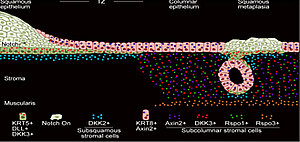Collaboration of epithelial transition zone niche and HPV/Chlamydia in establishing pathogenesis
Epithelial transition zones (TZ) of the uterine cervix, the boundary where columnar endocervical and squamous ectocervical epithelia meet constitute critical zones of enhanced disposition to localised Human papillomavirus (HPV) and Chlamydia infections. TZ is often predisposed to metaplastic adaptation that preceeds neoplasias, where one epithelial type replaces the neighbouring one. Several factors such as diet, acidic microenvironment, hormones are implicated in metaplasia development. Interestingly, active metaplastic changes in cervical TZ increases risk of HPV infections. Moreover, Chamydia infections are suggested to be a strong co-factor of HPV induced pathogenesis. Despite their strong association, thus far there has been no systematic analysis addressing why cervical TZ is more susceptible to infections and how infections impact the TZ niche and stem cell behaviour during pathogenesis. Here, we aim to investigate how HPV and Chlamydia alone or in combination affect cervical TZ niche including epithelial, stromal, and immune cell compartments. We will establish Chlamydia infections of cervical TZ in WT and KRT14-HPV transgenic mice that expresse the early region genes of HPV. Further, we will elucidate how Chlamydia colonises the cervical TZ of WT, HPV16 transgenic mice, how diet influences the infections and affects the TZ niche homeostasis and repair.The extent of alterations in the tissue compartments will be investigated using state of the art technologies such as organoid models, genetic lineage tracing, multiplexed single molecule RNA in situ hybridisations (smRNA-ISH), multicolor flow cytometry, single cells RNA (scRNA) sequencing as well as spatial transcriptomics.








